托福口语Task6答题案例解析
新托福口语Task 6难点解析及答题技巧(上)
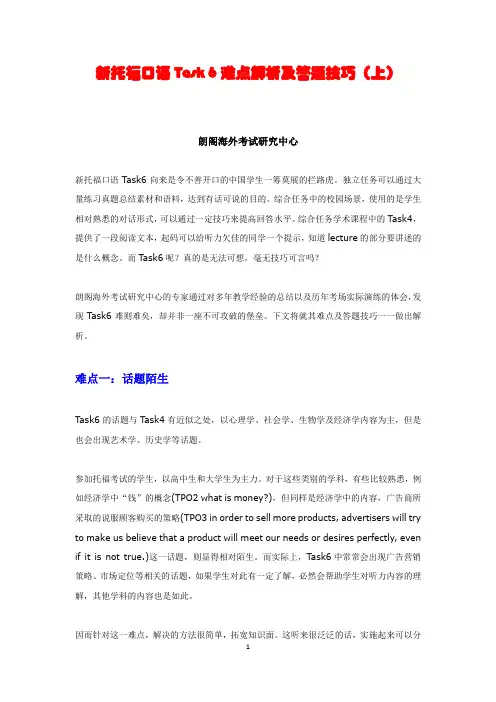
新托福口语Task 6难点解析及答题技巧(上)朗阁海外考试研究中心新托福口语Task6向来是令不善开口的中国学生一筹莫展的拦路虎。
独立任务可以通过大量练习真题总结素材和语料,达到有话可说的目的。
综合任务中的校园场景,使用的是学生相对熟悉的对话形式,可以通过一定技巧来提高回答水平。
综合任务学术课程中的Task4,提供了一段阅读文本,起码可以给听力欠佳的同学一个提示,知道lecture的部分要讲述的是什么概念。
而Task6呢?真的是无法可想,毫无技巧可言吗?朗阁海外考试研究中心的专家通过对多年教学经验的总结以及历年考场实际演练的体会,发现Task6难则难矣,却并非一座不可攻破的堡垒。
下文将就其难点及答题技巧一一做出解析。
难点一:话题陌生Task6的话题与T ask4有近似之处,以心理学、社会学、生物学及经济学内容为主,但是也会出现艺术学、历史学等话题。
参加托福考试的学生,以高中生和大学生为主力。
对于这些类别的学科,有些比较熟悉,例如经济学中“钱”的概念(TPO2 what is money?),但同样是经济学中的内容,广告商所采取的说服顾客购买的策略(TPO3 in order to sell more products, advertisers will try to make us believe that a product will meet our needs or desires perfectly, even if it is not true.)这一话题,则显得相对陌生。
而实际上,T ask6中常常会出现广告营销策略、市场定位等相关的话题,如果学生对此有一定了解,必然会帮助学生对听力内容的理解,其他学科的内容也是如此。
因而针对这一难点,解决的方法很简单,拓宽知识面。
这听来很泛泛的话,实施起来可以分为这样几个步骤:第一,TPO1-34中所有Task6均要彻底熟悉和练习。
第二,关注每场考试的考题回顾以及近段时间的考试机经,将其中T ask6所考到的内容进行梳理。
托福TPO1口语task6范文(题目答案解析)
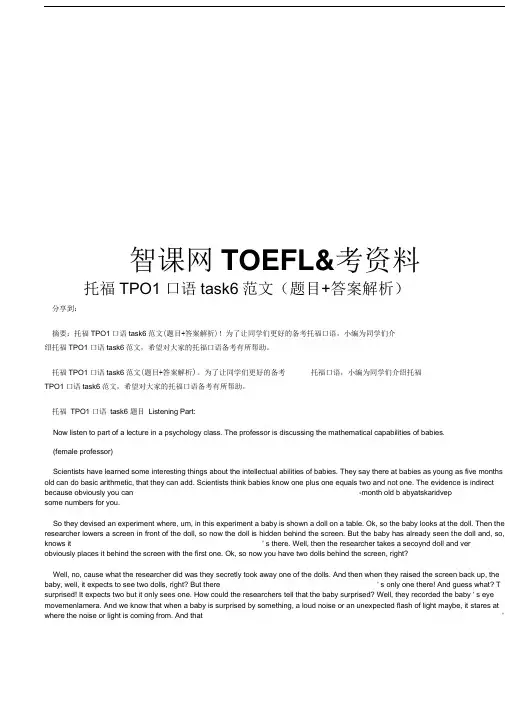
智课网TOEFL&考资料托福TPO1 口语task6范文(题目+答案解析)分享到:摘要:托福TPO1 口语task6范文(题目+答案解析)!为了让同学们更好的备考托福口语,小编为同学们介绍托福TPO1 口语task6范文,希望对大家的托福口语备考有所帮助。
托福TPO1 口语task6范文(题目+答案解析)。
为了让同学们更好的备考托福口语,小编为同学们介绍托福TPO1 口语task6范文,希望对大家的托福口语备考有所帮助。
托福TPO1 口语task6 题目Listening Part:Now listen to part of a lecture in a psychology class. The professor is discussing the mathematical capabilities of babies.(female professor)Scientists have learned some interesting things about the intellectual abilities of babies. They say there at babies as young as five months old can do basic arithmetic, that they can add. Scientists think babies know one plus one equals two and not one. The evidence is indirect because obviously you can -month old b abyatskaridvepsome numbers for you.So they devised an experiment where, um, in this experiment a baby is shown a doll on a table. Ok, so the baby looks at the doll. Then the researcher lowers a screen in front of the doll, so now the doll is hidden behind the screen. But the baby has already seen the doll and, so, knows it ' s there. Well, then the researcher takes a secoynd doll and ver obviously places it behind the screen with the first one. Ok, so now you have two dolls behind the screen, right?Well, no, cause what the researcher did was they secretly took away one of the dolls. And then when they raised the screen back up, the baby, well, it expects to see two dolls, right? But there ' s only one there! And guess what? T surprised! It expects two but it only sees one. How could the researchers tell that the baby surprised? Well, they recorded the baby ' s eye movemenlamera. And we know that when a baby is surprised by something, a loud noise or an unexpected flash of light maybe, it stares at where the noise or light is coming from. And that 'the experiment did. They stared, cause the babies know if you add one doll and one doll, you should have two dolls. So when it sees one doll, then it stares because it ' s surprised.托福TPO1 口语task6 题目Question:Using the research described by the professor, explain what scientists have learned about the mathematical abilities of babies.托福TPO1 口语task6答案解析:1. Listening keys(1.1) Main idea: Babies as young as five month old can do basic math(1.2) Example (study)(1.2.1) A baby is shown a doll on a table(1.2.2) A screen is lowered between the baby and the doll(1.2.3) A second doll is very obviously placed behind the screen(1.2.4) One of the dolls is secretly taken away(1.2.5) Screen is raised back up(1.2.6) Baby is surprised to see one doll, because it ' s expecting to see two(1.2.7) We know it ' s surprised because it stared(1.2.8) When a baby is surprised, it would stare托福TPO1 口语task6范文:Research suggests that babies as young as five month old can do some basic math. The professor gives us a study to confirm the suggestion is true. In the study, a baby is shown a doll on a table. Then the researcher lowers a screen in front of the doll, and puts a second doll behind the screen. But at the same time, they secretly take away one doll. When the screen is raised back up, the baby ' s surprised to see only one doll on the table instead of two. Theresearchers know it ' s surprised, because babies stare when surprised. This ist h ewconfirmed that a babies know one plus one equals two, not one.上述就是小编为同学们介绍的托福TPO1 口语task6范文(题目+答案解析)。
托福口语Task6 模板及高分答案
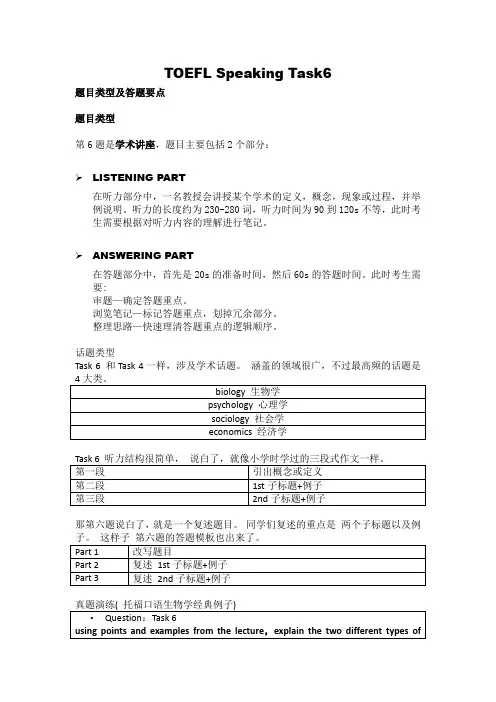
TOEFL Speaking Task6
题目类型及答题要点
题目类型
第6题是学术讲座,题目主要包括2个部分:
➢LISTENING PART
在听力部分中,一名教授会讲授某个学术的定义,概念,现象或过程,并举例说明。
听力的长度约为230-280词,听力时间为90到120s不等,此时考生需要根据对听力内容的理解进行笔记。
➢ANSWERING PART
在答题部分中,首先是20s的准备时间,然后60s的答题时间。
此时考生需要:
审题—确定答题重点。
浏览笔记—标记答题重点,划掉冗余部分。
整理思路—快速理清答题重点的逻辑顺序。
话题类型
Task 6 和Task 4一样,涉及学术话题。
涵盖的领域很广,不过最高频的话题是
那第六题说白了,就是一个复述题目。
同学们复述的重点是两个子标题以及例
从参考答案中,大家可以看出来第一句话改写题目是多么容易操作!Frontier前沿教育Esther 老师托福口语独家资料qq:397862712。
托福TPO45口语Task6听力文本题目满分范文
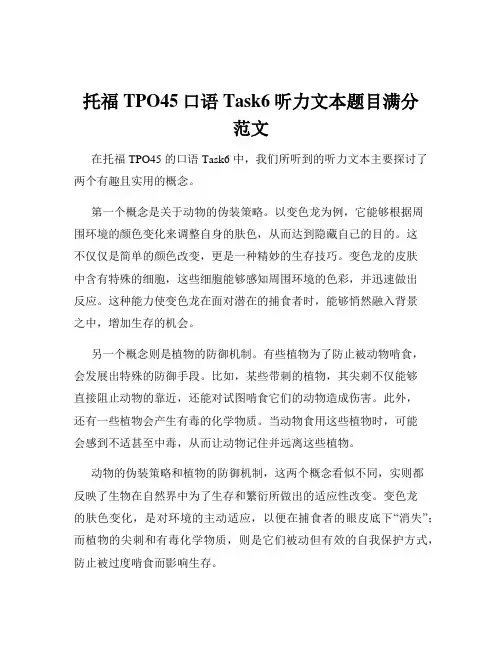
托福TPO45口语Task6听力文本题目满分范文在托福 TPO45 的口语 Task6 中,我们所听到的听力文本主要探讨了两个有趣且实用的概念。
第一个概念是关于动物的伪装策略。
以变色龙为例,它能够根据周围环境的颜色变化来调整自身的肤色,从而达到隐藏自己的目的。
这不仅仅是简单的颜色改变,更是一种精妙的生存技巧。
变色龙的皮肤中含有特殊的细胞,这些细胞能够感知周围环境的色彩,并迅速做出反应。
这种能力使变色龙在面对潜在的捕食者时,能够悄然融入背景之中,增加生存的机会。
另一个概念则是植物的防御机制。
有些植物为了防止被动物啃食,会发展出特殊的防御手段。
比如,某些带刺的植物,其尖刺不仅能够直接阻止动物的靠近,还能对试图啃食它们的动物造成伤害。
此外,还有一些植物会产生有毒的化学物质。
当动物食用这些植物时,可能会感到不适甚至中毒,从而让动物记住并远离这些植物。
动物的伪装策略和植物的防御机制,这两个概念看似不同,实则都反映了生物在自然界中为了生存和繁衍所做出的适应性改变。
变色龙的肤色变化,是对环境的主动适应,以便在捕食者的眼皮底下“消失”;而植物的尖刺和有毒化学物质,则是它们被动但有效的自我保护方式,防止被过度啃食而影响生存。
从更广泛的角度来看,这些现象也揭示了自然界中生物之间相互作用和相互影响的复杂性。
动物需要寻找食物,而植物需要防止被过度消耗,这种微妙的平衡在漫长的进化过程中逐渐形成。
对于我们人类而言,研究这些生物现象具有重要的意义。
在军事领域,动物的伪装技术启发了人们研发更先进的迷彩服和隐形装备,以提高士兵在战场上的隐蔽性。
在农业方面,了解植物的防御机制可以帮助农民更好地保护农作物,减少害虫和动物对庄稼的损害。
此外,这些生物现象也让我们更加深刻地认识到自然界的神奇和美妙。
每一种生物都有其独特的生存之道,都在为了适应环境而不断进化和改变。
这不仅让我们对生命的多样性充满敬畏,也激励着我们不断探索和学习,从自然界中获取更多的智慧和灵感。
如何拿下托福口语第六题
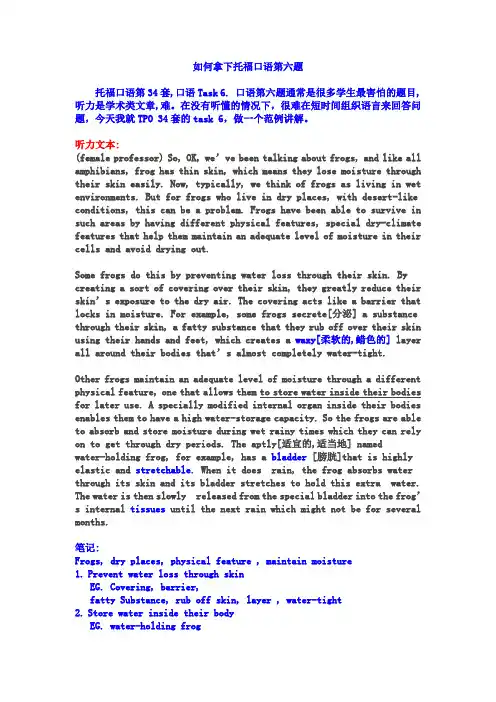
如何拿下托福口语第六题托福口语第34套,口语Task 6. 口语第六题通常是很多学生最害怕的题目,听力是学术类文章,难。
在没有听懂的情况下,很难在短时间组织语言来回答问题,今天我就TPO 34套的task 6,做一个范例讲解。
听力文本:(female professor) So, OK, we’ve been talking about frogs, and like all amphibians, frog has thin skin, which means they lose moisture through their skin easily. Now, typically, we think of frogs as living in wet environments. But for frogs who live in dry places, with desert-like conditions, this can be a problem. Frogs have been able to survive in such areas by having different physical features, special dry-climate features that help them maintain an adequate level of moisture in their cells and avoid drying out.Some frogs do this by preventing water loss through their skin. By creating a sort of covering over their skin, they greatly reduce their skin’s exposure to the dry air. The covering acts like a barrier that locks in moisture. For example, some frogs secrete[分泌] a substance through their skin, a fatty substance that they rub off over their skin using their hands and feet, which creates a waxy[柔软的,蜡色的] layer all around their bodies that’s almost completely water-tight.Other frogs maintain an adequate level of moisture through a different physical feature, one that allows them to store water inside their bodies for later use. A specially modified internal organ inside their bodies enables them to have a high water-storage capacity. So the frogs are able to absorb and store moisture during wet rainy times which they can rely on to get through dry periods. The aptly[适宜的,适当地] namedwater-holding frog, for example, has a bladder [膀胱]that is highly elastic and stretchable. When it does rain, the frog absorbs water through its skin and its bladder stretches to hold this extra water. The water is then slowly released from the special bladder into the frog’s internal tissues until the next rain which might not be for several months.笔记:Frogs, dry places, physical feature , maintain moisture1.Prevent water loss through skinEG. Covering, barrier,fatty Substance, rub off skin, layer , water-tight2.Store water inside their bodyEG. water-holding frogRain, absorb water through skin ,bladder stretches to hold water托福口语task6, 文章结构:Topic sentence: Frogs, dry places, physical feature , maintain moisture Sub topic 1position :Prevent water loss through skinExample :covering, barrier,fatty Substance, rub off skin,waxy layer , water-tightSub topic 2position:Store water inside their bodyExample : water-holding frogRain, absorb water through skin ,bladder stretches to hold waterSample Answer:The lecture introduced two dry-climate features of frogs.The first feature prevents water loss through their skin. Their skin can secrete a fatty substance, which they can rub all over their body using their hands and feet. And this waxy layer makes their skin watertight so as to reduce water loss.And other feature is modified internal organs that ensures higher water storage within their body. Frogs can absorb rain water through their skin,and store the water in their elastic bladder, so later the water can be released to their tissue to help the animal go for a long time. (8 sentences,104 words)。
【备考资料】托福TPO3口语Task6题目文本及答案解析[借鉴]
![【备考资料】托福TPO3口语Task6题目文本及答案解析[借鉴]](https://uimg.taocdn.com/f255f16600f69e3143323968011ca300a6c3f638.webp)
【备考资料】托福TPO3口语Task6题目文本及答案解析在托福口语备考中,想要快速提升自己的托福口语能力,除了不断的累积自己的词汇和句型之外,从TPO练习入手也不失为一个不错的方法。
那么,在以下内容我们就为大家带来托福口语TPO的题目和答案解析。
托福TPO3口语task6题目 Listening Part:Now listen to part of a lecture in a Psychology class. The professor isdiscussingadvertising strategies.Professor (female)In advertising various strategies are used to persuade people to buyproducts. In order to sell more products, advertisers will often try to make usbelieve that a product will meet our needs or desires perfectly, even if it’snot true. The strategies that they use can be subtle, friendly forms ofpersuasion that are sometimes hard to recognize.In a lot of ads, repetition is a key strategy. Research shows that repeatedexposure to a message, even something meaningless or untrue, is enough to makepeople accept it or see it in a positive light. You’ve all seen the carcommercials on TV like, uh, the one that refers to its roomy cars over and overagain. You know which one I mean.This guy is driving around and keeps stopping to pick up different people. Hepicks up three or four people. And each time, the narrator says, “Plenty of roomfor friends, plenty of room for family, plenty of room for everybody.” The same message is repeated several times in the course of the commercial. Now the car,the car actually looks kind of small, it’s not a big car at all, but you get thesense that it’s pretty spacious. You’d think the viewer would reach the logical conclusion that the slogan miss-represents the product, instead, what usuallyhappens is that when the statement “plenty of room” is repeated often enough,people are actually convinced it’s true.Um, another strategy they use is to get a celebrity to advertise a product.It turns out that we’re more likely to accept an advertisement claim made bysomebody famous, a person we admire and find appealing. We tend to think they’re trustworthy. So, uh, you might have a car commercial that features a well-knownrace car driver. Now, it may not be a very fast car, uh, it could even be aninexpensive vehicle with a low performance rating. But if a popular race cardriver is shown driving it and saying, “I like my cars fast!” Then people would believe the car is impressive with its speed.托福TPO3口语task6 答案解析:Using the examples from the talk, explain how persuasive strategies are usedin advertising.托福TPO3口语task6 答案解析:1. Listening keys(1.1) Main idea: two persuasion strategies that are used in advertising(1.2) First: repetition(1.2.1) Example: car ad, someone drives around, narrator keeps saying “plenty of room for everyone”.The audience will think the car is big although it’s small(1.3) Second: using celebraties(1.3.1) Example: car ad, famous race car driver drives a slow car, peoplewill think the car is pretty fast because people find famous people trustworthyand appealing.托福TPO3口语task6 范文:The professor talks about two strategies that are used in TV ads that willmake them more convincing. One strategy is repetition, when people hearsomething often enough, the message becomes positive. Take a car ad for example,the na rrator says “plenty of room for everyone” for many times, although the caris small, eventually people will start to think that the car is fairly big. Thesecond strategy is using a celebrity to advertise a product because people tendto believe someone famous. A race car driver who says “I like my car fast!” might actually make people think the car in the ad to be pretty fast, because wefind them trustworthy.本文部分信息来源于新东方在线。
运用逻辑 征服新托福口语:Task 6解析
运用逻辑征服新托福口语:Task 6解析在新托福口语考试中,高分考生的答案普遍都具有一个特点,那就是清晰(clear)和连贯(coherent)。
特别是在学术感很强的Task6部分,考生没有了阅读材料作参考,只能完全依赖听力材料,难度增加的同时,能否表达的清晰连贯就更加重要了。
在紧张的,有严格时间限制的考试过程中要做到这两个要求,一个最为行之有效的方法便是使用逻辑感非常强烈的句型。
在本文中,朗阁海外考试研究中心将主要针对新托福口语part 6,通过一些常见真题来探讨一下最能体现逻辑感的四大状语从句(即时间,原因,条件,让步)在考试当中的运用,从而帮助考生们有效展现清晰和连贯的语言能力。
一.四大条件状语从句1.时间状语从句【adverbial clause of time】:常用引导词:When, while, as, after, before, as soon as,since, till2.原因状语从句【adverbial clause of cause】:常用引导词:because, since, as, for特殊引导词:seeing that, now that, in that, considering that3.条件状语从句【adverbial clause of condition】常用引导词:if, unless,特殊引导词:as/so long as, only if, providing/provided that,supposing that, in case that, on condition that4.让步状语从句【adverbial clause of concession】常用引导词:though, although, even if, even though特殊引导词: as(用在让步状语从句中必须要倒装),while (一般用在句首),no matter …,in spite of the fact that,while,whatever, whoever, wherever, whenever, however, whichever 二.Task 6真题示范讲解题目简介:【讲课要点】:心理学讲儿童情绪。
详解托福口语task6
详解托福口语task6一.基本信息在托福口语task6中,考生会听一段90-120秒的听力,听力内容的长度大约在230-280个单词左右。
听力的主要内容是教授就某个学术问题比如生命科学,社会科学,自然科学和人文科学所做的讲座的节选。
听力文章的组织形式主要是在文章一开始,教授会先解释概念,主要是会强调一个问题或者介绍一种现象,然后教授会详细的讨论重要的方面和相关的观点,最后教授会用具体的有说明性的例子来解释或者阐明主要的概念或者问题。
考生在作答的时候要使用讲座中的观点和例子来说明其中的主要概念和问题。
在这个题目中考生的准备时间是20s,答题时间是60秒。
二.答题技巧1.提升听力水平在托福口语task6中并没有相对应的阅读内容能够协助考生提前预测文章的主要内容,所以考生如果想在这个题目中取得高分,就要注意提升自己的听力水平。
前程百利小编建议考生在练习听力的时候,首先练习听写,因为它能够协助考生解决在听力中理解而反应不过来的词汇问题。
其次,考生应该学会精听,精听能够协助大家提升对托福听力段子意思的理解水平。
大家实行精听练习的时候一定要作笔记,不停顿的听,共听五遍。
最后考生应该学会跟读,跟读侧重了托福听力的语音方面,只有能够说出来才能够听的懂。
只有准确的识别语音才能更好的听的懂,把题目作对。
建议考生在跟读的时候对着文本,将跟读材料详细精听至少三遍,着重留意连读、重读、语调、弱读和缩读,对于这些地方,要做有嘴型的默读练习。
2.掌握答题模板在回答这个题目的时候,考生应该学会掌握一些模板,通过使用模板提升自己的答题水平。
在这个题目中建议考生采用这个模板Inthe lecture, the professor discuss/argues/demonstrates….in several points/aspects. First, he says that and he gives an example of…. Second, he mentioned that …and he shows some data/researches about….。
【必备资料】托福TPO6口语Task6题目文本及答案解析
【必备资料】托福TPO6口语Task6题目文本及答案解析在托福口语备考中,想要快速提升自己的托福口语能力,除了不断的累积自己的词汇和句型之外,从TPO练习入手也不失为一个不错的方法。
那么,在以下内容我们就为大家带来托福口语TPO的题目和答案解析。
托福TPO6口语task6题目 Listening Part:Now listen to part of a talk in an Education class.(female professor)One of the hardest parts of teaching is keeping your students’ attention.Now, the key to doing this is understanding the concept of attention. Basically,there are two types of attention. The first type is active, active attention isvoluntary. It’s when you intentionally make yourself focus on something. Andsince it requires effort, it’s hard to keep up for long a time. OK, so, um,let’s say you are teaching a Biology class. And today’s topic is frogs. Allright? You’re standing in front of the room lecturing: a frog is a type ofanimal known as an amphibian…, well, this isn’t necessarily going to keep thestudents’ interest. But most of them will force themselves to pay activeattention to your lecture. But it’s only a matter of time before they getdistracted.Now, the other type of attention is passive attention, when it’s involuntary. Passive attention requires no effort because it happens naturally. If something is really interesting students don’t have to force themselves to pay attention to it. They do it without even thinking about it. So back to our Biologylecture, you start talking about frogs and then you pull a live frog out of your briefcase. You’re describing it while holding it up. Show the students how long its legs are, and how they’re used for jumping, for example. Then maybe even let the frog jump around a bit on the desk or the floor. In this case, by doing something unexpected, something more engaging, you can tap into their passive attention. And it can last much longer than active attention. As long as thefrog is still there your students will be interested.托福TPO6口语task6题目 Question:Using points and examples from the talk, explain the difference betweenactive and passive attention.托福TPO6口语task6 答案解析:1. Listening key(1.1) Main idea: active and passive attention(1.2) Active attention: forced(1.2.1) Example:(1.2.1.1) A teacher teaches a class by only reading from textbooks(1.2.1.2) Students will get bored, yet they’d still try to focus(1.2.1.3) But they will get distracted soon because this attention isforced(1.3) Passive attention: happens naturally(1.3.1) Example:(1.3.1.1) A teacher teaches with a live frog, let it jump around a bit(1.3.1.2) Students get interested in what’s happening, their concentration happens naturally(1.3.1.3) As long as the frog is on the table, students will have no problem focusing on the lecture托福TPO6口语task6 范文:The professor talks about two kinds of attention in the lecture. The first type is active attention which is voluntary. For example, if a biology teacher teaches a class by only reading from a textbook, the class can become fairlyboring. Most students would force themselves to focus, but sooner or later, the students will be distracted. The second type of attention is passive attention, let’s say instead of reading from a textbook, the teacher pulls a live frog out of his bag, then the lecture becomes really interesting. As long as the frog is on the table, the students will be able to focus on the lecture.本文部分信息来源于新东方在线。
托福TPO1口语task6范文(题目答案解析)
智课网TOEFL&考资料托福TPO1 口语task6范文(题目+答案解析)分享到:摘要:托福TPO1 口语task6范文(题目+答案解析)!为了让同学们更好的备考托福口语,小编为同学们介绍托福TPO1 口语task6范文,希望对大家的托福口语备考有所帮助。
托福TPO1 口语task6范文(题目+答案解析)。
为了让同学们更好的备考托福口语,小编为同学们介绍托福TPO1 口语task6范文,希望对大家的托福口语备考有所帮助。
托福TPO1 口语task6 题目Listening Part:Now listen to part of a lecture in a psychology class. The professor is discussing the mathematical capabilities of babies.(female professor)Scientists have learned some interesting things about the intellectual abilities of babies. They say there at babies as young as five months old can do basic arithmetic, that they can add. Scientists think babies know one plus one equals two and not one. The evidence is indirect because obviously you can -month old b abyatskaridvepsome numbers for you.So they devised an experiment where, um, in this experiment a baby is shown a doll on a table. Ok, so the baby looks at the doll. Then the researcher lowers a screen in front of the doll, so now the doll is hidden behind the screen. But the baby has already seen the doll and, so, knows it ' s there. Well, then the researcher takes a secoynd doll and ver obviously places it behind the screen with the first one. Ok, so now you have two dolls behind the screen, right?Well, no, cause what the researcher did was they secretly took away one of the dolls. And then when they raised the screen back up, the baby, well, it expects to see two dolls, right? But there ' s only one there! And guess what? T surprised! It expects two but it only sees one. How could the researchers tell that the baby surprised? Well, they recorded the baby ' s eye movemenlamera. And we know that when a baby is surprised by something, a loud noise or an unexpected flash of light maybe, it stares at where the noise or light is coming from. And that 'the experiment did. They stared, cause the babies know if you add one doll and one doll, you should have two dolls. So when it sees one doll, then it stares because it ' s surprised.托福TPO1 口语task6 题目Question:Using the research described by the professor, explain what scientists have learned about the mathematical abilities of babies.托福TPO1 口语task6答案解析:1. Listening keys(1.1) Main idea: Babies as young as five month old can do basic math(1.2) Example (study)(1.2.1) A baby is shown a doll on a table(1.2.2) A screen is lowered between the baby and the doll(1.2.3) A second doll is very obviously placed behind the screen(1.2.4) One of the dolls is secretly taken away(1.2.5) Screen is raised back up(1.2.6) Baby is surprised to see one doll, because it ' s expecting to see two(1.2.7) We know it ' s surprised because it stared(1.2.8) When a baby is surprised, it would stare托福TPO1 口语task6范文:Research suggests that babies as young as five month old can do some basic math. The professor gives us a study to confirm the suggestion is true. In the study, a baby is shown a doll on a table. Then the researcher lowers a screen in front of the doll, and puts a second doll behind the screen. But at the same time, they secretly take away one doll. When the screen is raised back up, the baby ' s surprised to see only one doll on the table instead of two. Theresearchers know it ' s surprised, because babies stare when surprised. This ist h ewconfirmed that a babies know one plus one equals two, not one.上述就是小编为同学们介绍的托福TPO1 口语task6范文(题目+答案解析)。
- 1、下载文档前请自行甄别文档内容的完整性,平台不提供额外的编辑、内容补充、找答案等附加服务。
- 2、"仅部分预览"的文档,不可在线预览部分如存在完整性等问题,可反馈申请退款(可完整预览的文档不适用该条件!)。
- 3、如文档侵犯您的权益,请联系客服反馈,我们会尽快为您处理(人工客服工作时间:9:00-18:30)。
托福口语Task6答题案例解析
要在托福口语考试中取得好好成绩,那就需要同学们在日常生活在进行许多的训练,把我考试中的答题技巧,新通教育为大家带来托福口语Task6答题案例解析供大家参考。
听力文本:
Scientists have learned some interesting things about the intellectual abilities of babies. They say there’s evidence that babies as young as five months old can do basic arithmetic, that they can add. Scientists think babies know one plus one equals two and not one. The evidence is indirect because obviously you can’t ask a five-month old baby to add up some numbers for you.
So they devised an experiment where, um, in this experiment a baby is shown a doll on a table. Ok, so the baby looks at the doll. Then the researcher lowers a screen in front of the doll, so now the doll is hidden behind the screen. But the baby has already seen the doll and, so, knows it’s there.
Well, then the researcher takes a second doll and very obviously places it behind the screen with the first one. Ok, so now you have two dolls behind the screen, right? Well, no, cause what the researcher did was they secretly took away one of the dolls. And then when they raised the screen back up, the baby, well, it expects to see two dolls, right? But there’s only one there!
And guess what? The baby surprised! It expects two but it only sees one. How could the researchers tell that the baby surprised? Well, they recorded the baby’s eye movement on camera. And we know that when a baby is surprised by something, a loud noise or an unexpected flash of light maybe, it stares at where the noise or light is coming from. And that’s what the babies in the experiment did. They stared, cause the babies know if you add one doll and one doll, you should have two dolls. So when it sees one doll, then it stares because it’s surprised.
很清楚我们知道这里的听力内容结构为:1 Topic+1 Experiment+Group1&Group2
那我们通过这段听力内容,我们要知道3个方面的内容:实验目的、实验过程、实验结果
intellec abilit babies
experime
a baby shown a doll on a table
hidden behind the screen
2nd doll with 1st one hidden screen
secretly took away one doll
expects to see two dolls
see only one
Surprised ∵eye movement
stares at
那么我们可以总结托福综合口语Task6的答题小技巧:
答案的第一句照着答题要求照念,无需组织。
在复述讲座例子时无需重复讲座中的所有信息,选取支撑观点的主要细节即可。
听到专业的学术词汇,一定可以根据其后的解释,推测出该单词的含义
听不懂的单词,记发音
答案的第一句照着答题要求照念,无需组织。
以下是不同的Question, 请按照此原则练习组织答案的第一句话。
Using the research described by the professor, explain what scientists have learned about the mathematical abilities of babies.
Using the examples from the talk, explain how persuasive strategies are used in advertising.
Using points and examples from the lecture, explain the two major factors of product quality and how their role in consumer decision-making has changed.
Using the points and examples from the talk, explain how substitute goods and complement goods influence demand for a particular product.
听到专业的学术词汇,一定可以根据其后的解释,推测出该单词的含义。
Um, another strategy they use is to get a celebrity to advertise a product. It turns out that we’re more likely to accept an advertisement claim made by somebody famous, a person we admire and find appealing. We tend to think they’re trustworthy. So, uh, you might have a car commercial that features a
well-known race car driver. Now, it may not be a very fast car, uh, it could even be an inexpensive vehicle with a low performance rating. But if a popular race car driver is shown driving it and saying, “I like my cars fast!”Then people would believe the car is impressive with its speed.
听到专业的学术词汇,一定可以根据其后的解释,推测出该单词的含义。
Another kind of narrator an author might use is an omniscient narrator. In this case, the narrator, the voice that is telling the story, knows everything, and I mean everything about the characters. So, let’s imagine our same man and woman traveling but described by an omniscient narrator. Not only do we, the readers, know what they do and say, but we also know what they’re thinking. For example, we’re told that the couple is going to visit an old friend of the man’s and we learn what the man is thinking that he is nervous because he hasn’t seen his friend in a long time, that he is worried if his wife would like the friend. So an omniscient narrator provides more information and answers questions that the reader might have about the characters or the action.。
